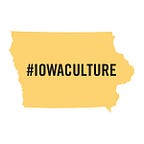Grinnell Artist Finds Meaning in the Making
You’d be wise to stick with the Grinnell artist Joe Tuggle Lacina if you ever stumble off the grid. He is as comfortable at its high-tech center as its primitive edges, as handy with a 3D printer as with a hammer and nails.
The tech assistant for Grinnell College’s art studios shows students the finer points of digital photography, laser cutting and all things 3D — scanning, modeling and printing. But he also makes things with his own two hands. After cleaning up debris from the 2020 derecho, he thought, “Well, I have this chainsaw now, so I’ve got to do some chainsaw carving. Don’t we all?”
Tuggle Lacina received an Iowa Artist Fellowship earlier this year from the Iowa Arts Council, and it’s a safe bet his multi-media skills are as “multi” as any of the 44 other fellows in the program’s 9-year history. He paints, sculpts and writes. He builds furniture, renovates spaces and creates virtual artwork, including those new-fangled non-fungible tokens, known as NFTs.
“I don’t really want to like virtual reality as much as I do, but it’s not going away,” he says. “It’s going to be more and more a part of our day-to-day experience.”
Tuggle Lacina’s own experience began on the family farm north of town, where he spent his early days doing chores, climbing trees, playing with Lego and tinkering with old electronics and farm equipment. He learned to draw and paint and perform with encouragement from his parents, who are artists in their own right. His mom has an M.F.A. in painting; his dad, a lawyer, studied music, loves theater and currently serves as the Grinnell Area Arts Council’s executive director.
Tuggle Lacina headed east for art school, in Baltimore, and moved to Philadelphia, where he co-founded a gallery called Extra Extra, worked at the popular Fabric Workshop and Museum, and was a guest curator at the Institute of Contemporary Art. He rubbed elbows with luminaries like Laurie Anderson, Nick Cave and Mel Chin. Once, he recalls, “Lou Reed asked me where to go for a good breakfast.”
While he was still in school, he brought some friends back home during the summer of 2006 to enjoy the fresh air and make some art. They exhibited — and sold — a lot of their work at the end of their stay, kick-starting the successful artist-in-residence program known as the Grin City Collective.
“For people who grow up on the East Coast or in big cities, going to a farm or just having a place that’s quiet or lower speed allows them to connect with their inner selves,” Tuggle Lacina says. “It gives them some clarity, some perspective.”
Tuggle Lacina came back most summers to help with the collective until he returned for good in 2012. He earned a pair of graduate degrees in dimensional practice from the University of Iowa before he and his wife, Laurel, had a son, Jamie, in 2021.
“Halfway through undergrad, I dropped the delusion of making it in New York,” he says. “There’s a whole constellation of options out there. My folks and I, we’re always sort of scheming about art organizations and art projects and ideas.”
For example: They’re converting their farm’s three-story corn crib, built in 1938, into an event and exhibition space called Grin Cupola. Tuggle Lacina hopes to open it next spring with a mix of in-person and virtual art shows throughout the year. He has developed the project’s plan during the professional development workshops that are part of his Iowa Artist Fellowship.
The fellowship also comes with a grant, which he plans to spend on a 3D printer and a virtual-reality headset. He’ll use them for VR sculpting demonstrations as well as his own artwork, like the series of VR busts of superheroes he imagined as a child and then minted as NFTs — virtual artworks to fill a virtual gallery and sell on the virtual market.
But despite its shiny new potential, the virtual world still makes Tuggle Lacina a little leery. Many of his physical paintings and sculptures question the limits of technology and artificial intelligence. For a piece called “Just Google It,” he built a wooden robot that does push-ups — so its creator doesn’t have to. He outsourced his own physical fitness.
In a painting called “Hiding from the State,” an all-seeing eyeball monitors a surreal landscape. In a found-object assemblage alled “Visions of the Future,” a deflated human-sized doll hangs down the side of a gray barrel like a wilted plant.
Even so, the restless creativity of Tuggle Lacina’s work lends it a sense of optimism. Because even if things could go wrong, it doesn’t mean they actually will. Things can be reinvented, redesigned or repurposed. He turned an old bike into a lamp. He frankensteined an antique wardrobe and a packing crate to make a functional new piece of furniture. He’s turning that old corn crib into a sunlit gallery, complete with a cupola that overlooks the family farm’s pastures, orchard and 1870s farmhouse.
The landscape hasn’t changed much since his great-grandparents settled here, “off the grid” before it even existed. They would have understood his instincts to use his tools, new and old, to make the property productive.
“It feels like a lifelong project,” he says. “Meaning is generated through making.”
— Michael Morain, Iowa Department of Cultural Affairs
